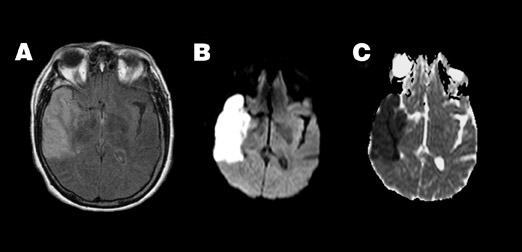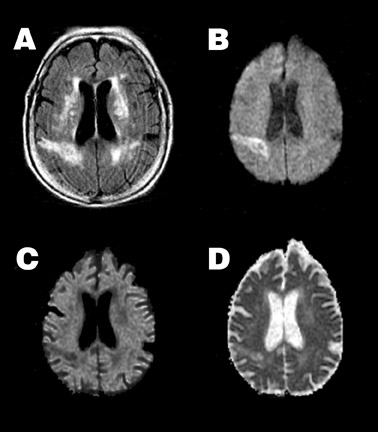Functional magnetic resonance imaging: New concepts in paradigm design and data analysis
Images



Dr. Maas received his SB, SM, and PhD degrees from the Massachusetts Institute of Technology, Cambridge, MA and his MD degree from Harvard Medical School, Boston, MA. He is currently completing his residency in Diagnostic Radiology at the University of California at San Francisco, CA. In 2004, he plans to begin a Fellowship in Magnetic Resonance Imaging at the University of California at San Diego.
Functional magnetic resonance imaging (fMRI) was introduced just over a decade ago as a new family of techniques to identify areas of dynamic brain function. By extending magnetic resonance imaging (MRI) beyond its traditional role of evaluating anatomy, fMRI offered researchers and clinicians another window into the realm of brain function previously dominated by positron emission tomography and electroencephalography. Unlike these earlier techniques, however, functional imaging with MRI brought together, for the first time, both high spatial and relatively high temporal resolution without the need for ionizing radiation.
As a result, fMRI has quickly become a staple technology of the basic neuroscience community, and new clinical applications in neurology, psychiatry, and neurosurgery also continue to emerge. Most recently, numerous scientific and poster sessions at the 11th Scientific Meeting of the International Society for Magnetic Resonance in Medicine (ISMRM) held in Toronto were devoted to basic neuroscience and clinical applications of fMRI, including evaluation of epilepsy, 1 neoplasm, 2-4 stroke, 5 multiple sclerosis, 6 pain, 7 human immunodeficiency virus infection, 8 drug abuse, 9,10 schizophrenia, 11,12 and posttraumatic stress disorder, 13 among many others. In addition to applications, a large body of work is directed at technical aspects of fMRI, with the goal of improving the basic experiment to yield higher sensitivity and specificity. Much of this work can be broadly divided into topics of experimental design, preprocessing of acquired data, and final data analysis. This article reviews traditional and emerging concepts in these areas, highlighting work presented at the 2003 ISMRM meeting.
Blood-oxygenation-leveldependent functional magnetic resonance imaging
By far, the most widely applied fMRI techniques are those based upon the blood-oxygenation-leveldependent (BOLD) contrast mechanism, 14 and thus, this article will focus on BOLD fMRI. The physiological basis of the observed BOLD signal changes is the coupling of neuronal activity and local blood flow. In response to the experimental stimulus or task, a localized increase in neuronal activity leads to an increase in local blood flow to the activated area. The degree of increased oxygen delivery, paradoxically, exceeds the increase in oxygen requirements of the activated neurons, resulting in a local increase in the concentration of oxygenated hemoglobin and corresponding decrease in that of deoxygenated hemoglobinin local capillaries, venules, and draining veins. Unlike oxyhemoglobin, deoxyhemoglobin has paramagnetic properties that increase local field inhomogeneity and, thus, cause local transverse magnetization dephasing effects that shorten the apparent transverse relaxation time (T2*) in the adjacent brain parenchyma. Therefore, the end result of the neuronal activation is a decrease in deoxyhemoglobin-induced dephasing and thus an increase in the measured signal on T2*-weighted sequences, as was first shown in studies of human subjects in 1992. 15-17
The observed signal changes in BOLD fMRI studies are small, ranging from 1% to 5% at 1.5T. Furthermore, the changes are not instantaneous, but rather, lag the onset or termination of stimulus or task by several seconds, typically 4 to 6 seconds, with a gradual upslope and downslope, as determined by the local hemodynamic response function (Figure 1). The underlying physiology of this hemodynamic response and the resulting BOLD signal continues to be an area of significant research, 18-22 a discussion of which is beyond the scope of this review. The interested reader is referred to early work by Boxerman et al, 23 as well as to several recently published books devoted to topics in fMRI. 24-26
Experimental design
Due to the low contrast-to-noise of the BOLD response, the classic BOLD experiment is based upon a block design for stimulus presentation. In this approach, the subject is presented with alternating intervals, or "blocks," of a stimulus condition and a rest condition during the acquisition of imaging data. 15-17 The stimulus usually entails performance of a task or stimulation of one or more of the senses. The intervals have traditionally been on the order of 30 seconds each, with a typical experiment containing on the order of 200 images encompassing about 3 occurrences of each condition, as shown in Figure 1. Variations on this basic block design have also been developed to address particular scientific questions. In studies of cognition and memory, for example, the rest condition may, in fact, represent a baseline task, with the stimulus condition representing a task of increased difficulty or requiring recruitment of a higher-level cognitive process.
While the block design remains the dominant approach to BOLD fMRI, particularly in studies involving sensorimotor stimuli, this approach is not well suited for many interesting applications, such as studies of events occurring infrequently or unpredictably. Fortunately, researchers have found that increasingly brief stimuli can still generate detectable BOLD signal changes, 27,28 and over time, a new experimental design paradigm has emerged, known as event-related or single-trial fMRI. 29,30 In the basic event-related experiment, a single instance of a task is performed or a single brief stimulus is applied in each experimental epoch and the resulting transient BOLD signal response is measured, as shown in Figure 2.
An early application of this design can be found in a study of infrequent target events by McCarthy et al. 31 From electroencephalography, it is known that the appearance of unpredictable events results in the well-described P300-evoked response potential. Clearly, a BOLD fMRI experiment based on stimuli to evoke this response is very well-suited to the event-related design (and poorly suited to a block design), and by using this approach, these researchers were able to successfully identify activation in prefrontal and parietal regions by averaging across multiple trials. While averaging across epochs is typically required because of the inherently lower contrast-to-noise in event-related fMRI compared with that in block design studies, it has also been shown that a single trial of a mental rotation task can result in detectable BOLD signal changes in the parietal cortex. 32
An area of current interest within the event-related fMRI community relates to studies with very short interstimulus intervals. Generally, epochs are made at least as long as the hemodynamic response of interest, that is, long gaps between brief stimuli, but it is also possible to design experiments with very short interstimulus intervals such that the stimuli are close enough together in time that their hemodynamic responses overlap. In this case, the linearity of the BOLD response becomes a critical issue in interpreting the overlapping event-related results, 33 as the hemodynamic response curve can no longer be isolated by simply averaging across epochs. This has resulted in many studies evaluating the linearity of BOLD fMRI signal changes and the settings under which linearity fails. 34-36
Preprocessing
After data acquisition is complete, fMRI data are generally processed by one or more preprocessing steps prior to data analysis, including Nyquist ghost reduction (in echoplanar imaging), slice-timing correction (for temporal offsets between adjacent slices in multislice imaging), motion correction, and temporal and spatial noise reduction. 24-26
Of these, the importance of image registration is particularly well-established in fMRI. At high signal contrast boundaries, such as the cortical surface and periventricular regions, for example, even small variations in subject alignment from image to image can result in large signal fluctuations, significantly increasing noise and reducing the sensitivity of the technique. Particularly troublesome is task-correlated motion that also results in decreased specificity by increasing the number of false-positive results, 37 an issue that is especially important in experimental designs requiring spoken responses. 38,39 Thus, evaluation of motion-correction related issues in BOLD fMRI in both traditional block and newer event-related experiments 39 remains an active area of research. 38-42
Another area of preprocessing that continues to receive much attention is the reduction of physiologic noise, with many methods evolving to attenuate undesired variations in the measured time courses due to respiration and cardiac pulsation effects 43-46 as well as machine-related noise such as scanner drift. 47 Similar to motion correction, specific issues of physiologic noise in event-related experiments are also being addressed. 45
Data analysis
The final step in fMRI is the analysis of the data, with goals of both detection and characterization of activation. These methods can be divided into two groups: hypothesis-driven and data-driven.
Hypothesis-driven techniques, also known as inferential techniques, rely on an a priori model of the underlying activation for detection and characterization. The most basic approach is to perform a Student's t -test or compute the closely related correlation coefficient 48 on a voxel-by-voxel basis. This readily allows the assignment of statistical significance to the areas of activation, permitting application of statistical detection thresholds. Generally, with t -testing, the rest and stimulus groups are shifted in time to account for the hemodynamic delays. Similarly, in correlation analysis, the reference waveform may be a shifted box-car function. Alternatively, a boxcar convolved with an estimate of the hemodynamic response curve may be used as the reference function, yielding increased sensitivity and specificity.
More sophisticated hypothesis-driven techniques are based upon multiple regression, where one or more paradigm-related reference functions and multiple additional physiologic noise functions can be entered as independent factors in the regression. If not addressed as a preprocessing step, the noise factors may include periodic functions at the observed respiratory and cardiac frequencies, global trends (usually ascribed to slow changes in hardware properties), and the motion correction displacement parameters obtained from the earlier registration step (which address residual effects of subject motion). Interaction terms can also be included to accommodate nonlinear responses. The group of regressors can be collectively assembled into a matrix, often referred to as the "design matrix." Because of the wealth of possible regressors, the choice of optimal design matrix remains an area of active research. 39 In addition, once the regression coefficients are computed, usually by an ordinary least-squares method, the residual error terms can be used to assign a level of statistical significance to activated voxels. Because of issues of multiple comparisons and both spatial and temporal autocorrelation of noise, much work also continues to be directed at techniques to determine the appropriate levels of statistical significance to assign to activated voxels. 49-53
The major limitation of all hypothesis-driven methods is the
requirement to define an a priori temporal model of the expected
activation. Thus, the sensitivity and specificity of these methods
will depend on how accurately the model reflects the observed
signal changes. This can be problematic, particularly in
event-related paradigms, where the temporal dynamics of the
response may be unknown, or in cognitive paradigms, where models of
brain activity patterns are not necessarily available. In response
to these limitations, a family of data-driven techniques has been
applied to fMRI that does not require a priori information
regarding the nature of the experiment. Instead, in "blind source
separation" techniques, experimental data are examined in their
entirety to extract various patterns of signal behavior, the
so-called spatial and temporal "modes" or "sources," such that a
linear combination of these modes can reconstitute the original
experimental data. In theory, data-driven methods have the ability
to detect unexpected results and may be less affected by spatial
variation in hemodynamic responses or multiple noise sources. Thus,
they can also be used in exploratory analysis of
fMRI data to identify potential regressor functions that can be
used subsequently in conventional hypothesis-driven analy-
sis. Data-driven approaches that have been applied in fMRI include
principal component analysis (PCA), independent component analysis
(ICA), canonical correlation analysis (CCA),
54
fuzzy clustering algorithms,
55
and temporal clustering.
56
The two most commonly applied of these techniques, PCA and ICA, are
discussed further in this section.
In PCA, the covariance between all pairs of time points or voxels is examined, and the eigenfunctions of the covariance matrix determined. These eigenfunctions, or, alternatively, the eigenimages, represent the orthogonal temporal or spatial modes of the data, respectively, with the major eigenfunctions accounting for the largest portions of the observed variability in the underlying signals. In concept, one assumes that the patterns that systematically capture the most variance are the most likely to reflect interesting biological activity. The major limitation of PCA is that by definition, only uncorrelated basis functions can result, such that temporally or spatially correlated behaviors in the data sets are poorly separated. Thus, while PCA results can be examined directly to identify uncorrelated patterns of activity, PCA is more commonly used as a dimension reduction tool, where the data are projected onto a subset of the major eigenfunctions.
An alternative data-driven technique that has been increasing in popularity in recent years is ICA. It has been adapted from the field of neural networks and was first applied in fMRI by McKeown et al 57 in 1998. Like PCA, ICA seeks to identify separate patterns of signal behavior in the fMRI data set. As the name reflects, ICA attempts to identify components that are as statistically independent from each other as possible, a stronger criterion than the uncorrelated condition in PCA. Thus, ICA generally results in improved separation of sources when compared with PCA. 58 ICA is generally configured to seek spatially independent sources (sICA), 57 but in limited circumstances, temporal independence (tICA) can also be sought. 58 For interested readers, a review of both spatial and temporal ICA approaches can be found in Calhoun et al. 59
Two implementations of ICA have been frequently applied in fMRI, the Infomax algorithm 57,60 and the fixed-point algorithm. 61 As reviewed by Esposito et al, 62 each shows slightly different behavior. Briefly, in simulations, the fixed-point algorithm generally provides higher spatial and temporal accuracy when inferential statistics are employed as benchmarks, but the adaptive Infomax algorithm provides better global estimation of the ICA model and superior noise reduction capabilities, and may be preferable when the activation under investigation is not known or adequately modeled by inferential techniques.
The major limitations of data-driven techniques include the lack of residuals or error terms to determine goodness-of-fit and the lack of direct statistical testing for detection of activation, although secondary methods to determine these parameters have been developed. 63,64 In addition, because ICA is based on a neural-network system, it is sensitive to initial conditions, and slightly different results are produced with each repeated application of ICA to the same data, complicating reproducibility. Furthermore, unlike PCA, components are returned in random order in ICA, and, thus, several ranking methods are under development to determine the most "important" components. 65,66 Despite these limitations, independent component analysis and other data-driven techniques are likely to become a staple fMRI tool, particularly in exploratory analysis of new experimental paradigms where a model of the expected BOLD signal changes has not yet been developed.
Conclusion
The number of applications of functional MRI, both in basic neuroscience and clinical settings, continues to grow each year. As higher field scanners with increased contrast-to-noise increasingly become the norm for functional studies, smaller and smaller activations will become detectable. Extension of parallel imaging techniques to fMRI studies 67,68 will only further increase temporal and spatial resolution. As these technical refinements allow for investigation of more and more complex facets of cognition and disease, it is expected that ongoing developments in paradigm design, preprocessing, and data analysis will also increase in importance. Thus, it is critical for those interested in functional imaging to familiarize themselves with new technical concepts in fMRI, particularly event-related experimental design and exploratory data-driven analysis techniques, such as independent component analysis.
Appendix
In reviewing the methods of many of the fMRI investigators presenting at the 2003 ISMRM conference in Toronto, it was evident that two data analysis software packages have been widely adopted by the fMRI community. These are the Statistical Parametric Mapping package (SPM, Functional Imaging Laboratory, Wellcome Department of Imaging Neuroscience, Institute of Neurology, University College London, UK) originally developed by Friston 50 ; and the Analysis of Functional NeuroImages package (AFNI, National Institute of Mental Health, Bethesda, MD) developed by Cox. 69 Both packages provide powerful tools for preprocessing, statistical analysis, and visualization of results. Exploring these packages may be a worthwhile activity for those interested in beginning fMRI research. Computer code for these packages is available online at www.fil.ion.ucl.ac.uk/spm and http://afni.nimh.nih.gov/afni, respectively. In addition, code implementing the Infomax algorithm is available from the Computational Neurobiology Laboratory (Salk Institute for Biological Studies, La Jolla, CA) at www.cnl.salk.edu and code for the fixed-point algorithm (FastICA) can be obtained from the Laboratory of Computer and Information Science, Helsinki University of Technology, Helsinki, Finland at www.cis.hut.fi.
Related Articles
Citation
Functional magnetic resonance imaging: New concepts in paradigm design and data analysis. Appl Radiol.
February 2, 2004